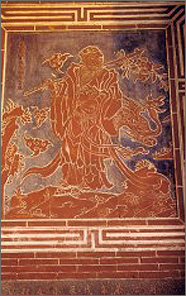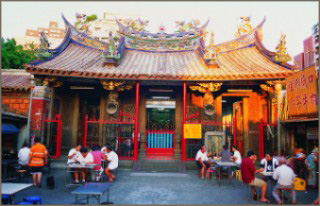 |
 |

Founding Year : 1787
God Worshipped : Ching-shuei Tzu-shih(Birth date : January 6)
Religion : Buddhism
Relic Classification : 3rd Degree Relic
Location : 81, Kungding Rd, Wanhua District, Taipei
Phone : (02) 23711517
|
|
|
|
|

Ching-shuei-yen is also called "Tzu-shih Miao " since the Temple worships Ching-shuei Tzu-shih. It was built in 1787 by Moun-gar citizen who immigrated from Anshi County , Chuanchow Prefecture of Fukien Province, mainland China. Ching-shuei-yen of Anshi is not only the center of Buddhism in Fukien Province but also the birthplace of Ching-shuei Tzu-shih prevalent in Taiwan and southeast Asia. The Temple underwent renovation in 1817, reconstruction in 1867 because of being burned up in the disputes among local gangs, and a second reconstruction in 1958 because World WarⅡ had ruined the Temple. Besides, in 1896 and 1922 the Temple had served as a temporary school, playing the role of local education.
|

|

People in Taiwan have customarily called Ching-shuei Tzu-shih the "black face Tzu-shih," "Fung-lai Tzu-shih ", and so on. Ching-shuei Tzu-shih was born in 1044 at a small village of Yungchun County , Fukien Province during the Northern Song dynasty. He had studied Buddha sutras since childhood and practiced medicine around Ma-chang. Once Anshi County was plagued by a grave drought; however, it did rain immediately after Ching-shuei Tzu-shih prayed for rain. Then, the villagers of the Anshi County asked him to stay at the Mt. Feng-lai to practice Buddhist rules; from then on, the villagers addressed him as "Ching-shuei Tzu-shih." And the naming of "Ching-shuei Tzu-shih" originated from the following anecdote: While practicing Buddhist rules on Mt. Feng-lai, Ching-shuei Tzu-shih lived in a hut inside the mountain cave. Because the water running through the rock cave was crystal clear ("crystal clear" is pronounced "ching-shuei" in Mandarin Chinese) and chilly (pronounced "yen" in Mandarin), so the Buddhist master called his dwelling "Ching-shuei-yen" (in Chinese, "rock" is also pronounced "yen").
|
 |

The engraving of a dragon on a wall and that of a tiger on the other wall of the Ching-shuei-yen were arts works installed in 1817 when the Temple underwent reconstruction. The couplets on the main entrance jointly contributed by Wung Juei-yu and Weng Chung-yu also belonged to 1817 arts works. In addition, there were stone pillars with dragons writhing on them and octagonal pillars. As for the ancient plaque, only one left; that is the one conferred from Emperor Kuang-shi of the Ching dynasty.
|
|
|
|
|